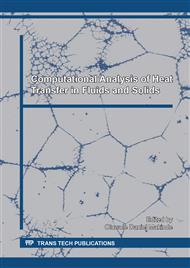[1]
S.U.S. Choi, Enhancing thermal conductivity of fluids with nanoparticles, ASME Fluids Eng. Division, 231 (1995) 99–105.
Google Scholar
[2]
L G Leal, Advanced Transport Phenomena: Fluid Mechanics and Convective Transport Processes, Cambridge University Press, New York, (2007).
Google Scholar
[3]
W. A. Khan, O. D. Makinde, Z. H. Khan, Non-aligned MHD stagnation point flow of variable viscosity nanofluids past a stretching sheet with radiative heat, Int. J. Heat Mass Transf. 96 (2016) 525-534.
DOI: 10.1016/j.ijheatmasstransfer.2016.01.052
Google Scholar
[4]
W. Ibrahim, O. D. Makinde, Magnetohydrodynamic stagnation point flow and heat transfer of Casson nanofluid past a stretching sheet with slip and convective boundary condition. Journal of Aerospace Engineering, 29(2), (2016).
DOI: 10.1061/(asce)as.1943-5525.0000529
Google Scholar
[5]
O. D. Makinde, M. S. Tshehla, Unsteady hydromagnetic flow of radiating fluid past a convectively heated vertical plate with the Navier slip. Advances in Mathematical Physics, 2014 (2014) Article ID 973593(10pages).
DOI: 10.1155/2014/973593
Google Scholar
[6]
M. Sheikholeslami, M.K. Sadoughi, Simulation of CuO-water nanofluid heat transfer enhancement in presence of melting surface, Int. J. Heat Mass Transf. 116 (2018) 909–919.
DOI: 10.1016/j.ijheatmasstransfer.2017.09.086
Google Scholar
[7]
A. Zeeshan, N. Shehzad, R. Ellahi, Analysis of activation energy in Couette-Poiseuille flow of nanofluid in the presence of chemical reaction and convective boundary conditions, Res. in Phys. 8 (2018) 502–512.
DOI: 10.1016/j.rinp.2017.12.024
Google Scholar
[8]
A Ur Rehman, R Mehmood, S Nadeem, N S Akber, S S Motsa, Effect of single and multi wall carbon nanotubes on water and engine oil based rotating fluids with internal heating, Adv. Powder Tech.
DOI: 10.1016/j.apt.2017.03.017
Google Scholar
[9]
M.K. Nayak, N.S. Akbar, V.S. Pandey, Z.H. Khan, D. Tripathi, 3D free convective MHD flow of nanofluid over permeable linear stretching sheet with thermal radiation, Powder Technol. 315 (2017) 205-215.
DOI: 10.1016/j.powtec.2017.04.017
Google Scholar
[10]
M.K. Nayak, MHD 3D flow and heat transfer analysis of nanofluid by shrinking surface inspired by thermal radiation and viscous dissipation, Int. J. Mech. Sci. 124 (2017) 185-193.
DOI: 10.1016/j.ijmecsci.2017.03.014
Google Scholar
[11]
O. D. Makinde, A. Aziz, Mixed convection from a convectively heated vertical plate to a fluid with internal heat generation. ASME, Journal of Heat Transfer, 133 (2011) article # 122501 (6pages).
DOI: 10.1115/1.4027606
Google Scholar
[12]
O. D. Makinde, A. Aziz, Boundary layer flow of a nanofluid past a stretching sheet with aconvective boundary condition.International Journal of Thermal Sciences, 50 (2011) 1326-1332.
DOI: 10.1016/j.ijthermalsci.2011.02.019
Google Scholar
[13]
A Pantokratoras, E Magyari, MHD free-convection boundary-layer flow from a Riga-plate, J Eng. Math. 64 (2009) 303-315.
DOI: 10.1007/s10665-008-9259-6
Google Scholar
[14]
R. Ahmad, M. Mustafa, M Turkyilmazoglu, Buoyancy effects on nanofluid flow past a convectively heated vertical Riga-plate: A numerical study, Int. J. Heat Mass Transf. 111 (2017) 827–835.
DOI: 10.1016/j.ijheatmasstransfer.2017.04.046
Google Scholar
[15]
M. K. Nayak, S. Shaw, O. D. Makinde, A. J. Chamkha, Effects of Homogenous–Heterogeneous reactions on radiative NaCl-CNP nanofluid flow past a convectively heated vertical Riga plate, J. Nanofluids.
DOI: 10.1166/jon.2018.1501
Google Scholar
[16]
T. Hayat, A. Kiran, M. Imtiaz, A. Alsaedi, M. Ayub, Melting heat transfer in the MHD flow of a third-grade fluid over a variable-thickness surface, Eur. Phys. J. Plus 132 (2017) 265, DOI 10.1140/epjp/i2017-11519-4.
DOI: 10.1140/epjp/i2017-11519-4
Google Scholar
[17]
M. K. Nayak, G. C. Dash, L. P. Singh, Steady MHD flow and heat transfer of a third grade fluid in wire coating analysis with temperature dependent viscosity, Int. J. Heat Mass Transf. 79 (2014) 1087–1095.
DOI: 10.1016/j.ijheatmasstransfer.2014.08.057
Google Scholar
[18]
G. J. Reddy, A. Hiremath, M. Kumar, Computational modeling of unsteady third-grade fluid flow over a vertical cylinder: A study of heat transfer visualization, Results in Phys.8 (2018) 671–682.
DOI: 10.1016/j.rinp.2017.12.054
Google Scholar
[19]
C. Cattaneo, C. D. C. Sulla, Atti Sem. Mat. Fis. Univ. Modena 3(1948) 83–101.
Google Scholar
[20]
C.I. Christov, On frame indifferent formulation of the Maxwell-Cattaneo model of finite-speed heat conduction. Mech Res Commun 36(4) (2009)481–486.
DOI: 10.1016/j.mechrescom.2008.11.003
Google Scholar
[21]
M. Imtiaz, A. Alsaedi, A. Shafiq, T. Hayat, Impact of chemical reaction on third grade fluid flow with Cattaneo-Christov heat flux, J.of Mol. Liq. 229 (2017) 501–507.
DOI: 10.1016/j.molliq.2016.12.103
Google Scholar
[22]
T. Hayat, S. Nadeem, Flow of 3D Eyring-Powell fluid by utilizing Cattaneo-Christov heat flux model and chemical processes over an exponentially stretching surface, Results in Phys. 8 (2018) 397–403.
DOI: 10.1016/j.rinp.2017.12.038
Google Scholar


